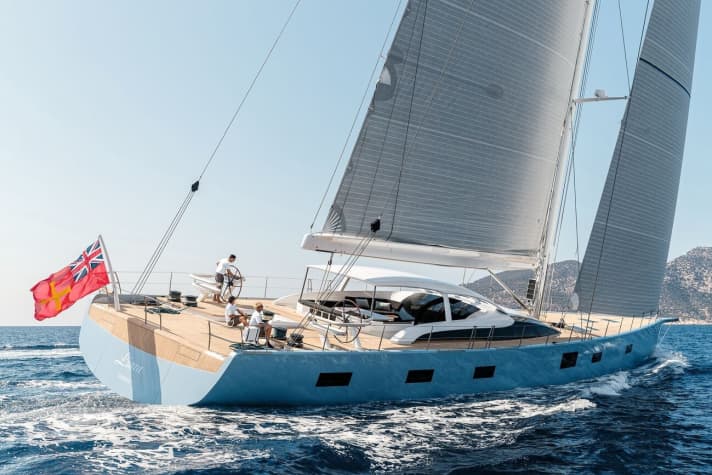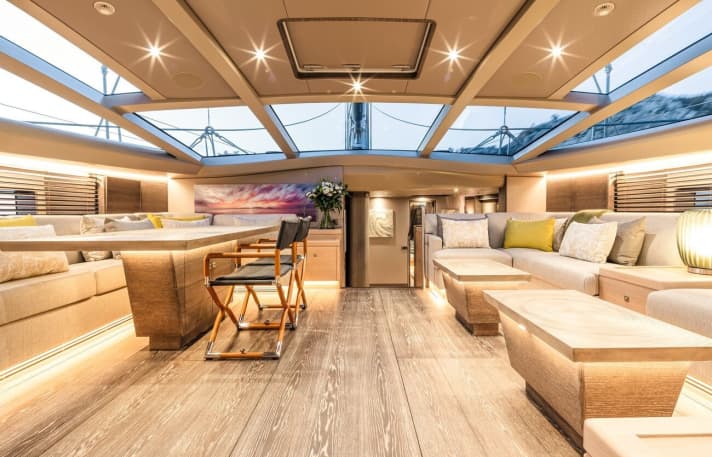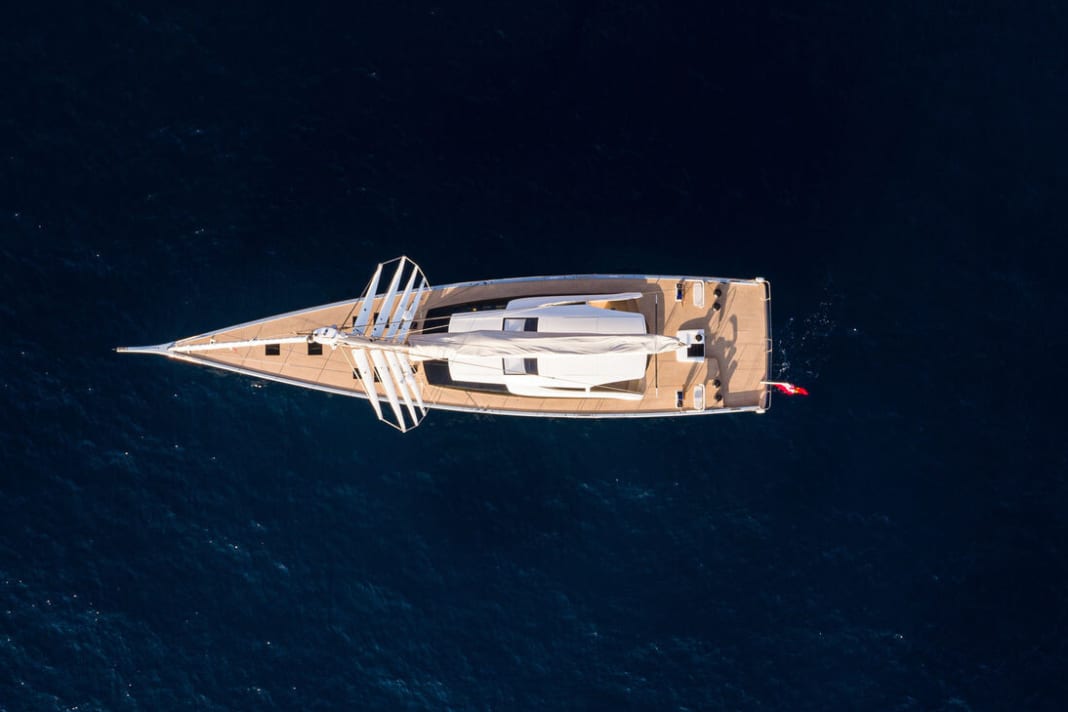

This story begins with a dream come true. "I've been sailing for as long as I can remember," says the British "Liara" owner, leaning comfortably against the pushpit as his new 34-metre Baltic makes its way out of the crowded Port Hercule. "I have owned numerous sailing yachts, from 20-footers to my last yacht, a 32-metre Bill Dixon design (now "Danneskjold"), which was launched by Southern Ocean in 2009. We travelled extensively with her and took part in several regattas. However, a Baltic has always been high on my yacht wish list - but you have to be able to afford it first."
It was worth the wait - the latest "Liara" is a prime example of the art of yacht building, which the Finnish company has truly perfected since it was founded in 1973. Owners who order from Baltic have precise ideas - outstanding quality, lightweight construction and innovation are just some of the keywords that yacht connoisseurs think of when the name of the shipyard from Pietarsaari is mentioned. "The owner's original idea was to put a sporty family cruiser on the water," explains yacht designer Malcolm McKeon, whose studio MMYD was commissioned to develop the hull lines and style the exterior. "However, the whole plan changed quite quickly when it became clear that 'Liara' would also be sailing regattas. We had to radically rethink and make sure that we saved as much weight as possible on all levels." Under the leadership of project manager Tommy Johansson, the shipyard workers adhered to the strict weight plan and, thanks to their commitment and inventiveness, even achieved a displacement of 88 tonnes, which was less than the calculated empty weight. With the help of CFD (Computational Fluid Dynamics) programmes, the design team optimised the appendages and hull lines so that the "Liara" crew can look forward to a clearly noticeable gain in performance, especially in light to medium winds.
"The integration of the Retractable Propulsion System, or RPS for short, made a huge difference," says McKeon. The pivoting pod propulsion unit moves out of the hull in less than a minute and just behind the keel, giving the captain intuitive joystick control so that even tight berths are no longer a challenge. "Anyone with even a little knowledge of hydrodynamics will immediately realise that the yacht accelerates considerably faster without the drive train extended and is noticeably more agile to steer during regatta starts and at turning points," says the yacht designer, commenting on the innovative system. Another advantage of the RPS is that the entire unit can be retracted into the hull when not in use at anchor or in the harbour and stored dry thanks to the overpressure system - this reduces fouling and protects the entire mechanical system. 31-year-old captain John Walker, who runs "Liara" in rotation with skipper Tom Haycock, points out the system's only catch: "You just have to plan exactly when to drive the RPS into the hull - because then the compact propulsion nacelle is no longer available to you spontaneously and at a moment's notice." What's more, the engine can only be extended when "Liara" is travelling at less than six knots - precise and foresighted planning of the engine manoeuvres is therefore essential. In return, you are rewarded with 0.2 to 0.5 knots more speed under sail.

The project manager also counts the positioning of the RPS hull opening in the immediate vicinity of the telescopic keel as one of the complex design challenges. "We worked on this for a whole eight months and were still on schedule in the end," says the engineer proudly. The telescopic keel manufactured by APM in Italy reduces the draught from 6.15 to 3.91 metres hydraulically at the touch of a button and, together with the bomb, has an impressive ballast weight of 31 tonnes. The MMYD team worked intensively on reducing the wetted surface and on the hydrodynamic optimisation of the hull appendages. "A huge advantage of the telescopic keel in contrast to the conventional lift keel is that no massive keel box destroys valuable living space in the saloon," explains Baltic salesman Marcus Jungell as he descends through the companionway into the bright saloon. The owner hired Adam Lay to design the interior after seeing the interior of the 32-metre Baltic "Inukshuk", which was delivered in 2013, created by the British designer. "I was asked to create a practical and functional interior with smart and versatile storage options that feels open and bright and is inspired by the nature of the Channel Islands - the owner's hometown," says Adam Lay, explaining the design brief.
Soft and muted colours that can be found in the nature of Guernsey and Jersey predominate on board. The natural charm is garnished with plenty of indirect light, which adds depth and cosiness to the rooms. Lay had the surfaces of the furniture and floors hand-finished by the shipyard joinery so that the interior looks as if it has aged naturally over the years. "We love our cosy and warm interior," enthuses the owner. There are further references to nature everywhere on board. The surfaces of the dining table and sofa tables have been treated to resemble small waves of wind on a smooth water surface. The wall unit fronts suddenly remind "Liara" visitors of coarse tree bark. The only notable splashes of colour in the interior are provided by individual cushions and paintings by Guernsey-based painter Valerie Travers.
The owner did not dare to experiment with the layout. His spacious suite is located in the bow, with a VIP cabin to port and an inviting entertainment lounge with flat-screen TV and L-shaped sofa opposite. The aft saloon impresses with its sheer size, open-plan layout and brightness. Large window panels in the superstructure flood the room with natural light and visually connect the spacious guest cockpit with the exterior. "Liaras' saloon is unrivalled in size for a 34-metre yacht," says Adam Lay. "We owe this to Malcolm McKeon's team, who radically optimised the layout by integrating the telescopic keel - we were then able to fill the available space according to the owner's wishes." Two almost identically divided guest cabins are located aft of the saloon, with the spacious crew quarters including galley, mess room, laundry, office and navigation corner, captain's cabin and two double cabins with en-suite bathrooms located behind. "The crew area is very spacious for a 34-metre sloop," comments Marcus Jungell. "Thanks to his wealth of experience, the owner knows how important it is for the social climate on board for the crew to have enough living space with as much comfort as possible."

In addition, "Liara" is one of the few sailing yachts to be skippered by two captains in rotation. The two 31-year-old skippers, John Walker and Tom Haycock, clocked up many miles on J-Class and large maxi yachts and finally got to know each other on the 32-metre "Liara", the owner's predecessor yacht. "We accompanied the construction of the new 'Liara' at Baltic and even during this time we dreamed of realising a rotation system for the new build," says John Walker as he steers "Liara" south-east towards Nice. "We have a fantastic travel and regatta programme for the next two years, and our boss gives us a completely free hand in planning our work assignments." This also allows the two young family fathers to achieve a good work-life balance. The owner also utilised the large yacht experience of the two skippers when planning the cockpit layout. "I wanted 'Liara' to be easy and quick to sail, even with the regular crew," he explains. Just how quickly "Liara" is ready to sail is impressively demonstrated by the crew at Cap-d'Ail. The Windex on the Southern Spars mast, which rises 45 metres into the sky, registers a minimal increase in the true wind from one to four knots - a gentle breeze, nothing more. "I think we should set sail," says John Walker with a smile and steers "Liara" into the wind, while deckhand Thorben Rapp clears the main halyard. Less than a minute later, the 437-square-metre main and the 301-square-metre genoa are flapping in the wind. Although the word "flapping" hardly does justice to the tired movements of the rather stiff North Sails 3Di laminate.
All the more impressive is the acceleration that the 88-tonne displacement Baltic newbuild achieves in these light wind conditions. The log immediately jumps to seven knots, clearly visible on the four Sailmon displays in XL format positioned directly in front of the mainsheet traveller, which show a whole range of useful information in real time and large letters - course to wind, true wind, course, speed over ground, depth. "Thanks to our sporty hydraulic package, we can even set the main in less than thirty seconds in race mode. But the Harken deck winches are not super enthusiastic about these special operations," explains the captain, handing over the helm to me. In the meantime, the thermal breeze has built up and the instruments show a constant wind of nine knots, while "Liara" is travelling at 10.5 knots and is already gliding towards Nice. The rudder pressure on the perfectly shaped carbon fibre steering wheel is pleasant, and "Liara" responds to steering commands as if she were a sporty 34-footer - and not a 34-metre yacht!
In the meantime, the owner has moved into the guest cockpit and made himself comfortable on one of the cosy sofas behind the companionway. He knows his "Liara" is in safe hands and uses the time for a long afternoon nap in the shade of the permanently installed bimini. "The hardtop can be removed for regattas," says John Walker. "However, the operation has to be well planned, as the bulky shade provider weighs several hundred kilos."
With her sporty sail plan, the innovative RPS, the telescopic keel and the hydraulic system designed for high pressures and thus high winch speeds, "Liara" is one of the most technically sophisticated sailing yachts that have been launched in recent years. A big dream has come true for the owner. "I can't imagine a better sailing life," he says, satisfied and well-rested. "We will spend this winter in the Caribbean, sail in one or two big yacht regattas next spring and then slowly but surely make our way towards New Zealand so that we can be in the front row at the America's Cup off Auckland in 2021 and also get involved in the planned superyacht races there." Right at the front, of course!







